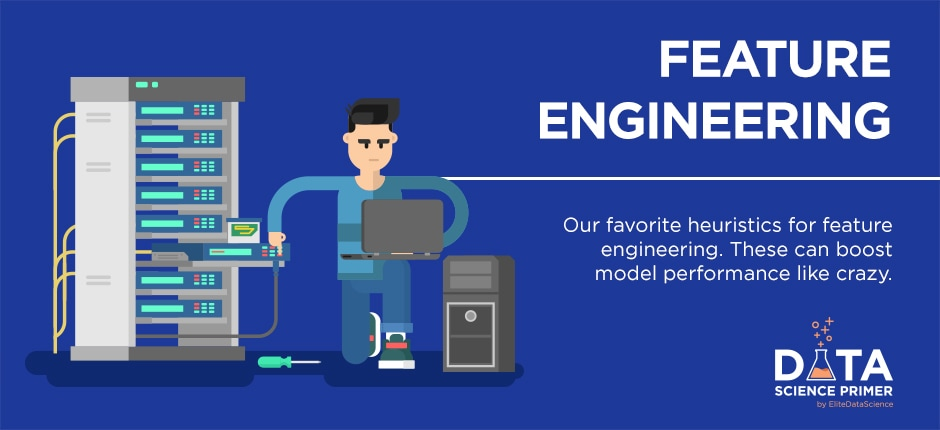Feature Engineering: The Art of Crafting Input Data for Improved Machine Learning Models
Feature Engineering: In the ever-evolving realm of machine learning, the secret sauce to building accurate and robust models lies not just in sophisticated algorithms, but in the input data itself. This is where the art of Feature Engineering steps in, wielding the power to transform raw data into a more informative and predictive format. In this journey through the nuances of feature engineering, we’ll explore how the craft of refining input data can significantly enhance the performance of machine learning models.
Anúncios

Understanding Features and Their Essence
At the heart of every machine learning problem lie features – those fundamental attributes that breathe life into your data. These features aren’t just data points; they’re the building blocks upon which machine learning models stand.
Think of your dataset as a complex puzzle, and each feature as a unique piece. Just as a puzzle piece fits seamlessly into the overall picture, a well-crafted feature seamlessly integrates into the model’s understanding of the data.
Feature engineering, the art of crafting and selecting these attributes, is akin to being a sculptor of insights. It involves identifying the most relevant, informative features, enhancing their significance, and sometimes even creating entirely new ones. This meticulous process is where the magic happens.
Engineered features can unlock hidden treasures buried deep within your data. They have the power to reveal intricate patterns and relationships that might have otherwise remained concealed. They illuminate the path for machine learning models to make accurate predictions, transforming raw data into actionable intelligence.
Anúncios
So, when diving into the world of machine learning, remember that features are the bedrock upon which your models are constructed. Nurture and refine them, and you’ll find yourself on a journey of discovery, where data isn’t just information; it’s a wellspring of invaluable insights.
Data Preprocessing: Laying the Groundwork
In the intricate realm of data preprocessing, the initial strides are often the most critical. Before embarking on feature engineering, it’s crucial to ensure your data is clean and ready for transformation. This foundational step sets the stage for accurate and reliable insights.
One of the foremost challenges encountered is dealing with missing values. These elusive gaps in your data can subtly distort your analysis and model outcomes. Employing advanced techniques such as imputation becomes imperative. Imputation involves artfully filling in these gaps, whether through statistical measures or machine learning algorithms. This meticulous process helps restore completeness to your dataset.
Anúncios
Yet, the data preprocessing journey doesn’t end there. The specter of outliers looms large. These data points, lying far from the norm, can wield disproportionate influence over your models. To mitigate their impact, practitioners turn to techniques like truncation or capping. These methods rein in outliers, preventing them from skewing your analysis and ultimately enhancing model performance.
In conclusion, data preprocessing is the bedrock upon which data science endeavors stand. By addressing missing values and outliers with precision and expertise, you pave the way for more accurate and insightful analyses, setting the stage for data-driven success.
Feature Extraction: Extracting Insights from Data

Sometimes, your dataset might contain complex information that’s not directly usable by machine learning algorithms. This is where feature extraction comes in. Techniques like Principal Component Analysis (PCA) can help distill the essence of your data by reducing its dimensionality while retaining the most important information. If you’re dealing with text data, NLP techniques can transform words into numeric features, ready to be ingested by your models.
Leveraging Domain Knowledge for Feature Creation
One of the most potent tools in feature engineering is your domain expertise. By understanding the intricacies of the problem you’re solving, you can create features that capture relevant insights. For instance, if you’re predicting housing prices, features like proximity to schools, hospitals, and transportation hubs can significantly enhance the predictive power of your model. Additionally, feature selection becomes paramount, as not all features contribute equally to the outcome. Selecting the most relevant features prevents noise from overpowering signal.
Creating New Dimensions: Interaction and Combination
In the realm of data analysis and modeling, sometimes the magic lies in the interactions between features. It’s not just about considering individual variables in isolation, but rather, exploring how they dance together in a symphony of data. By combining two or more features, you have the potential to unearth entirely new dimensions of information, each holding its own nugget of predictive power.
Consider this scenario: imagine merging a person’s age with their income. The result is not just a sum; it’s a glimpse into their spending behavior. This fusion of attributes can uncover patterns and tendencies that might remain obscured when examining age and income separately.
But it doesn’t stop there. In the quest for predictive accuracy, we encounter the concept of polynomial features. These come into play when the relationships between features take on a non-linear form. Polynomial features capture the intricacies and nuances that linear models might overlook. They add layers of complexity, enabling your models to better grasp the underlying patterns in the data.
In essence, the art of data analysis often involves weaving together the threads of interaction and combination. It’s a process that can unveil hidden insights, transforming your understanding of the data and, ultimately, enhancing your ability to make informed decisions.
Temporal Insights: Time-Series Feature Engineering

In the dynamic realm of time-series data, feature engineering takes on a distinct temporal flavor. Here, we delve into the intricacies of crafting meaningful features that can unlock valuable insights.
One of the cornerstone techniques in this journey is the art of lag features. This approach involves harnessing the power of historical data points as features. Imagine, in the context of stock market prediction, how the previous day’s closing price can serve as a vital predictor for today’s price movement. These temporal breadcrumbs can be breadcrumbs leading to predictive gold.
However, the temporal toolkit doesn’t stop there. Enter the realm of rolling windows, a potent concept in time-series analysis. Rolling windows allow us to calculate statistics over time windows, encapsulating trends and seasonality. Whether you’re deciphering temperature fluctuations or predicting website traffic, these rolling windows can shed light on patterns that evolve over time.
In essence, time-series feature engineering is a captivating dance with temporal data. It’s about transforming raw time sequences into a symphony of insights, where lag features and rolling windows play the role of virtuoso performers. These techniques hold the key to unveiling the hidden rhythms and melodies within your data, offering a richer understanding of the temporal landscape.
Handling Categorical Variables: Numeric Conversion
Machine learning models thrive on numbers, and categorical variables often need conversion. One-Hot Encoding is a technique where each category becomes a binary feature, indicating its presence or absence. However, this can lead to the curse of dimensionality. For high cardinality categories, Feature Hashing offers a workaround by mapping categories to a fixed number of hash buckets.
Optimizing for Tree-based Models

Different models have different appetites for feature engineering. Tree-based models, like Random Forests and XGBoost, can benefit from techniques like target encoding, where categorical variables are replaced with the mean of the target variable for each category. This encodes valuable information about the relationship between the feature and the target. Frequency encoding, where categories are replaced by their occurrence frequency, can also be effective.
Feature Scaling and Normalization
While some algorithms, like decision trees, are robust to different feature scales, others, like k-nearest neighbors or gradient descent-based algorithms, are sensitive. Feature scaling ensures that features are on the same scale, preventing the dominance of certain features due to their magnitudes. Standard scaling transforms features to have a mean of zero and a standard deviation of one, while Min-Max scaling scales features to a common range.
Mitigating Skewed Data Distribution
In some cases, your data’s distribution might be skewed, with a few instances having significantly higher or lower values. This can impact model performance, especially for algorithms sensitive to data distribution. Log transformation can help mitigate right-skewed distributions by compressing large values. Power transformation can also reshape data distributions, making them more amenable to modeling.
Tackling Time-Dependent Data
Time-series data requires a different approach to feature engineering. Creating lag features involves using past observations as features for the current observation. For example, predicting tomorrow’s weather might involve using today’s weather data. Rolling windows, on the other hand, involve calculating statistics like mean or standard deviation over time windows, capturing changing trends.
Advanced Techniques: Beyond the Basics
As the field of machine learning evolves, so do feature engineering techniques. Embeddings are a sophisticated approach where categorical variables are transformed into continuous vectors, capturing relationships between categories. Autoencoders, a form of neural network, can learn complex features by reconstructing input data. These advanced techniques can unlock new levels of feature representation.
Tools and Libraries for Feature Engineering

Feature engineering, while creative, can be time-consuming. Fortunately, there are tools and libraries that streamline the process. Featuretools is an automated feature engineering library that generates features based on predefined primitives. Scikit-learn, a versatile machine learning library, offers various preprocessing techniques for feature engineering, making it a staple for many data scientists.
Assessing the Impact of Feature Engineering
In the intricate realm of data science, feature engineering wields the power of a double-edged sword. While it possesses the potential to elevate model performance to new heights, it also carries the risk of introducing noise into the equation if executed without meticulous care.
To navigate this delicate balance, the tool of choice is often cross-validation. This technique slices your data into multiple subsets, allowing for both training and testing phases. It’s the litmus test to measure how well your model truly generalizes to new, unseen data. An indispensable step in the model evaluation process, cross-validation acts as a safeguard against the allure of overfitting, ensuring that your model doesn’t become overly attuned to the idiosyncrasies of the training data.
But the journey doesn’t end there. Enter the world of feature importance analysis, a compass guiding you through the labyrinth of feature relevance. This method illuminates the contribution of each feature to your model’s predictions. By identifying the key players and the mere spectators in your feature set, you can make informed decisions about which features to retain, refine, or bid farewell.
In conclusion, feature engineering, while a potent ally, requires cautious scrutiny. The judicious use of cross-validation and feature importance analysis serves as a sentinel, guarding against the noise and pitfalls that may arise. It’s the path to ensuring that your data-driven insights stand strong in the face of real-world challenges.
Avoiding Pitfalls and Navigating Challenges
While feature engineering is a powerful tool, it comes with its own set of challenges. Data leakage, where information from the future is accidentally used in the past, can lead to overly optimistic results. Overfitting, the danger of building a model too tailored to the training data, can lead to poor generalization on new data. Balancing complexity and generalization is a constant challenge.
Real-world Instances of Effective Feature Engineering
Effective feature engineering isn’t just theoretical—it yields tangible results in real-world applications. In image classification, features like edge detection, color histograms, and texture analysis can significantly boost model accuracy. In natural language processing, transforming text into features like word embeddings or TF-IDF representations can enhance the understanding of textual data.
Contribution to Ensemble Models
Feature engineering’s impact isn’t limited to standalone models. In ensemble methods like boosting and bagging, diverse features contribute to diverse models, ultimately enhancing the ensemble’s predictive power. Stacking, a technique where multiple models’ predictions are combined, can benefit from varied features, capturing complementary patterns.
Conclusion
Feature engineering is the unspoken hero behind many successful machine learning models. It’s the process of crafting data into a form that allows algorithms to learn, generalize, and predict effectively. From cleaning and transformation to domain expertise and advanced techniques, feature engineering is both an art and a science. In the dynamic landscape of machine learning, mastering this art can be the key to unlocking the full potential of your models, ultimately paving the way for more accurate predictions and insights.
Feature Engineering FAQ
What is feature engineering in machine learning?
Feature engineering involves creating, selecting, and transforming input features to improve the performance of machine learning models.
Why is feature engineering important?
Quality features provide models with relevant information, leading to better understanding and prediction of data patterns.
What are features in machine learning?
Features are individual data attributes that influence a model’s prediction. They can be numerical, categorical, or text-based.
How does feature engineering enhance model performance?
Effective feature engineering helps models capture underlying patterns and relationships, leading to more accurate and robust predictions.
What are some common techniques for data preprocessing?
Data preprocessing involves handling missing values and outliers, scaling, and transforming data distributions.
How does feature extraction work?
Feature extraction involves transforming raw data into a more informative format. Techniques like PCA and NLP are used to distill essential insights.
What role does domain knowledge play in feature engineering?
Domain knowledge guides the creation of features that capture relevant insights specific to the problem being solved.
What is feature interaction, and why is it important?
Feature interaction involves combining features to create new dimensions of information. It’s crucial for capturing complex relationships that might affect predictions.
How does time-series feature engineering differ from traditional feature engineering?
Time-series feature engineering involves incorporating temporal aspects, such as lag features and rolling statistics, to capture patterns over time.
What are categorical variables, and how are they handled in feature engineering?
Categorical variables are non-numeric attributes. They’re converted into numerical format using techniques like one-hot encoding or feature hashing.
How do you optimize features for tree-based models? Tree-based models benefit from features like target encoding and frequency encoding, which incorporate target variable information.
What is feature scaling, and when is it necessary? Feature scaling ensures that features are on a similar scale, preventing some features from dominating due to their magnitudes.
How does feature engineering address skewed data distribution? Techniques like log transformation and power transformation reshape skewed data distributions, enhancing model performance.
What are some advanced feature engineering techniques? Advanced techniques include embeddings, which transform categorical variables into continuous vectors, and autoencoders for unsupervised feature learning.
How do tools and libraries aid in feature engineering? Tools like Featuretools automate feature generation, while libraries like Scikit-learn offer preprocessing techniques for efficient feature engineering.
How can you evaluate the impact of feature engineering? Cross-validation assesses how well models generalize. Feature importance analysis helps gauge the contribution of features to predictions.
What challenges are associated with feature engineering? Challenges include data leakage, where future information leaks into past data, and overfitting, which occurs when models are too tailored to training data.
Can you provide real-world examples of effective feature engineering? In image classification, features like color histograms and edge detection enhance accuracy. In NLP, transforming text into embeddings improves understanding.
How does feature engineering contribute to ensemble models? In ensemble methods, diverse features enhance individual models, contributing to a more powerful ensemble’s predictive capability.
How can one learn more about effective feature engineering? Exploring online resources, books, courses, and practical applications will deepen your understanding and expertise in feature engineering.
Conclusion
In the dynamic realm of machine learning, feature engineering emerges as an essential craft, transforming raw data into actionable insights. With a blend of creativity, domain knowledge, and analytical skills, practitioners wield the power to enhance model performance, capture hidden patterns, and craft predictive features. This process is not only an art but a science that elevates the capabilities of machine learning models, ultimately leading to accurate predictions and valuable insights.
To delve further into the world of AI-driven capabilities, explore the intricacies of Natural Language Processing Demystified: Building Language-Enabled Applications with AI. This exploration into language processing will unravel the intricate web of language comprehension, opening doors to the creation of intelligent applications that interact and understand human language.
Read more about this content, click here.